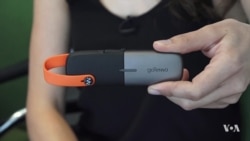Natural disasters like earthquakes and powerful storms can be a threat not only to human life, but to telecommunication systems.
When telecommunication networks go down, communities are unable to communicate with each other. But the United States has a system to help Americans get re-connected through wired or wireless technology. It also can provide important information in an emergency.
It is called mesh networking.
Mesh networks spread connectivity over a number of nodes or connection points that communicate with each other. The first such network was developed for military purposes.
Daniela Perdomo is head of goTenna, a company that specializes in mesh networking. It creates products that use low-frequency radio waves to send text messages and Global Positioning System (GPS) information.
The company’s latest product is the goTenna Mesh, a mesh networking device that works independently of traditional cell phone networks.
Joshua King is lead developer at Commotion Wireless, which creates software products for mesh networks. King said one good reason for mesh networks is that if one connection goes down, others take its place.
"A mesh network can potentially route around any kind of damage, if there is another path for the traffic to go," he noted.
If at least one network point is connected to the internet, the signal can be shared. If there is no internet connection, a mesh network can still operate to provide emergency information and basic messaging services, like texts.
Greta Byrum is director of the Resilient Communities program at the New America research center.
"The idea is to make telecommunication systems more modular, more distributed. So that even if centralized points fail, you would still have working telecommunications in different areas."
King and Byrum attended a recent gathering, called Sneakercon, at Columbia University in New York City. They and other attendees met to discuss the building of offline networks in local communities.
"I think it's important for thinking about the future of utilities and telecommunications, because we're finding more and more that centralized systems just don't make sense."
Byrum and others teach communities how to build their own mesh networks with everyday equipment.
"[It's] about community control, community power,” she said. “People start thinking about things like telecommunications sovereignty — who controls the internet, who controls what we say online, who benefits from it, who gets the data?"
Daniela Perdomo agrees that people should be more involved in issues of connectivity.
"Why can't we empower people to create their own connectivity? And create more of a people-powered, bottom-up network as opposed to a heavy infrastructure top-down network?"
I’m Jonathan Evans.
Tina Trinh reported this story for VOANews. Jonathan Evans adapted her report for Learning English. George Grow was the editor.
______________________________________________________________
Words in this Story
infrastructure – n. the basic equipment and structures that are needed for a country, area or organization to operate
offline – n. not connected to a computer, a computer network, or the Internet
sovereignty – n. a country's right to govern itself
low-frequency – adj. radio waves with frequencies much lower than the signals normally used in communications equipment
route – n. a path or line of travel







